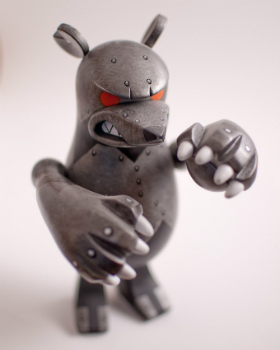The Future of War essays: The attack of the robot rats in the Korean War of 2019

By Col. Gary Anderson, USMC (Ret.)
Best Defense future of war department, red team director
The bomb that killed the president of
the United States on May 31, 2019, was small but powerful. So was the
one that killed two members of the Joint Chiefs of Staff and blew the legs of
their chairman during their weekly meeting at the Pentagon. The question of how
someone could penetrate the security of the two most secure buildings in
Washington might have triggered conspiracy theories for decades to come if
events halfway around the world in Korea, where similar explosions disabled key
American and South Korean military command posts, had not provided an ominous
answer. Simultaneously, much of Seoul was leveled by a devastating massive
artillery and rocket barrage. All this was the first stage of the Second Korean
War.
The North Korean force that crossed the
Demilitarized Zone, and overran most of South Korea within two weeks has been
described as a "horde." In reality, it was smaller than the U.S. and South
Korean force that opposed it. To be sure, the vast number of armed North
Koreans who followed the assault force was larger than the allied force, but it
was primarily tasked with population control, exterminating South Korean
political and intellectual leadership, and providing security against stay-behind
resistance fighters as well as American and South Korean Special Forces. In
reality, what caused the havoc in Washington and Korea was a revolution in
military affairs that Western planners had overlooked.
While the United States concentrated on
large robotic unmanned aerial systems to gather intelligence and deliver
precision weaponry, the North Koreans were going small with ground robotics.
The devices that infiltrated the Pentagon and the White House were about the
size of a small cell phone and were camouflaged to look like rodents. Indeed,
one alert White House aide spotted one of the devices, but instead of sounding
the alarm, she called for a General Services exterminator. The North Koreans
had also developed highly lethal enhanced explosives as payloads to be carried
aboard the tiny robotic assassins.
Half a world away, the counterparts of
the Washington assassins were similarly small. Instead of carrying explosives
they carried miniature cameras and transmitters that allowed them to send
pictures and even sound from their target locations. There were hundreds of
these devices. They had been planted by sleeper agents, and were located at
every key road intersection, bridge, cloverleaf, and airfield. The devices were
transmitting by satellite relay to the commanders of the North Korean assault
columns. Every time an allied unit tried to maneuver through one of these key
points or launch aircraft from airfields, they were instantly targeted by enemy
artillery. Except for the robots equipped for sabotage and assassination, which
were fairly complex to allow infiltration, these forward observer robots were
relatively simple. Once hidden in their overwatch locations, they were just
mobile enough and smart enough to move to more secure locations if they
perceived proximate danger. They too were roughly disguised as rodents, and so the
Americans began to call them "rats."
In addition, the North Korean tactical
commanders knew where the Americans and South Koreans were not located, which enabled them to find gaps and maneuver around and
behind the allies. When the U.N. forces tried to counter these maneuvers, they
found themselves pinned down by deadly indirect fire. Within 14 days, the
allies found themselves holding on to an enclave around the port of Pusan. The
situation did not begin to stabilize until the allies began using dogs,
detector devices, and even children to find and eliminate the tiny robotic
spies. Once again, the adaptability and resourcefulness of American soldiers
and Marines compensated for the lack of foresight of their leaders. But a long
slog lay ahead if the South was to be re-liberated.
As with the Germans in the Second World
War, the North Korean blitzkrieg was not a revolution in military affairs with
wonder weapons. The northerners had used existing technology in a combined arms
approach that created strategic surprise among their opponents who had counted
on technology and an all seeing overhead operational picture. Instead, it was
the North Koreans, moving through a cloud of instantaneous real-time intelligence,
who achieved information dominance.
Ironically, the Americans had
experimented with this concept in the latter years of the 20th century,
but it was abandoned after 9/11. There was much more money in large automated
airborne systems. The world saw that the Americans spent billions, but were beaten
by a foe that invested millions.
Gary Anderson is a retired Marine Corps colonel. He teaches red teaming
at the George Washington University's Elliott School of International Affairs.
Thomas E. Ricks's Blog
- Thomas E. Ricks's profile
- 436 followers



